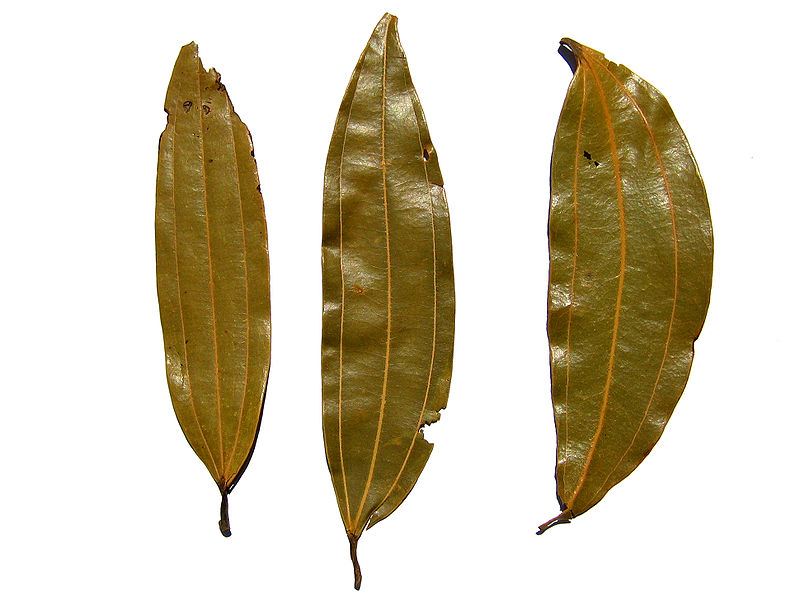肉桂(學名:Cinnamomum cassia)為樟科常綠喬木,又名玉桂、牡桂。
Cinnamomum aromaticum
cassia or Chinese cinnamon,
野生肉桂
http://en.wikipedia.org/wiki/File:CinnamonLeaves.jpg

http://zh.wikipedia.org/zh-tw/%E8%82%89%E6%A1%82
科: 樟科 Lauraceae
屬: 樟屬 Cinnamomum
種: 肉桂 C. cassia
肉桂(學名:Cinnamomum cassia)為樟科常綠喬木,又名玉桂、牡桂。
特徵
高達10米以上,樹皮灰褐色,樹皮厚可達13毫米,具強烈辛辣芳香味。葉互生或近對生;長橢圓形,或橢圓披針形,長8-20厘米,寬3-5.5厘米;頂端急尖,葉基寬楔形;全緣,具離基三出脈。圓錐花序頂生或腋生;花小,徑5毫米,花被裂片橢圓形,長3毫米。果橢圓形,長10毫米,徑7-8毫米,熟時紫黑色。
用途
植物各部,如其樹皮、枝、葉、果、花梗都可提取芳香油或桂油,用於食品、飲料、香煙及醫藥,但常用作香料、化妝品、日用品的香精。樹皮出油率為2.15%,桂枝出油率為0.35%,桂葉出油率為0.39%,桂子(幼果)出油率為2.04%。
肉桂原產中國,分布於廣西、廣東、福建、雲南等濕熱地區,其中尤以廣西最多。台灣、越南、寮國、印度尼西亞等地亦有分布。肉桂大多為人工栽培,且以種子繁殖為主,這樣可使其後代保持親本的特性,以獲得枝下較高的樹榦,有利於剝取桂皮,因此在生產上很少用無性繁殖方法培育苗木種植。多於秋季剝取,颳去栓皮、陰乾。因剝取部位及品質的不同而加工成多種規格,常見的有企邊桂、板桂、油板桂、桂通等。生用。
中醫學
肉桂各部位又可分別用於醫藥,樹皮也就是人們常說的桂皮,為中國傳統名貴中藥材,也作調味品,有驅風健胃、活血祛瘀、散寒止痛之效;樹枝則能發汗驅風,通經脈,詳見桂枝條目。
取自"http://zh.wikipedia.org/zh-tw/%E8%82%89%E6%A1%82"
Dried cassia bark
http://en.wikipedia.org/wiki/File:Cassia_bark.jpg

肉桂和肉桂粉
http://en.wikipedia.org/wiki/File:Canel ... _crop1.jpg

錫蘭肉桂
Cinnamomum verum---true cinnamon, Ceylon cinnamon or Sri Lanka cinnamon
錫蘭肉桂(學名:Cinnamomum verum)是雙子葉植物藥樟科樟屬植物,原產斯里蘭卡,在中國廣東海南、廣西南寧、台灣均有栽培。其樹皮,亦稱錫蘭肉桂。
在歐美,英文所稱 Cinnamon 多指此類。
葉與花
http://en.wikipedia.org/wiki/File:Cinnamomum_verum1.jpg

Ceylon cinnamon (Cinnamomum verum) on the left, and Indonesian Cinnamon (Cinnamomum burmannii) quills
http://en.wikipedia.org/wiki/File:Cinna ... mannii.jpg

2.
土肉桂
Cinnamomum osmophloeum---pseudocinnamomum or indigenous cinnamon
http://en.wikipedia.org/wiki/Cinnamomum_osmophloeum
土肉桂(學名:Cinnamomum osmophloeum)為樟科樟屬的植物,是台灣的特有植物。分布在台灣,生長於海拔400米至1,500米的地區,多生於常綠闊葉林中。目前在台灣花蓮縣鳳林鎮以及南投縣中寮鄉已經有人工栽培。
http://en.wikipedia.org/wiki/File:Cinna ... hloeum.jpg

http://www.hljh.tcc.edu.tw/teach/%E6%A0 ... %A1%82.htm
臺灣森林特產物土肉桂
http://ejournal.stpi.org.tw/NSC_INDEX/J ... 902-05.pdf
3.
Malabathrum, also known as Malobathrum or Malabar leaf
柴桂
Cinnamomum_tamala
http://commons.wikimedia.org/wiki/File: ... G_2433.jpg

乾葉子
藥用
http://en.wikipedia.org/wiki/File:India ... rblatt.jpg

4.
Saigon Cinnamon
(Cinnamomum loureiroi, also known as Vietnamese cinnamon or Vietnamese cassia and Quế Trà My or Quế Thanh in Vietnam) is an evergreen tree in the genus Cinnamomum, indigenous to mainland Southeast Asia. Despite its name, it is more closely related to Cassia (C. aromaticum) than to Cinnamon (C. verum), though in the same genus as both. Saigon cinnamon has 1-5% essential oil in content and 25% cinnamaldehyde in essential oil, which is the highest of all the cinnamon species. Consequently, out of the three forms of Cassia, it commands the highest price.
The scientific name was originally spelled as Cinnamomum loureirii, but because the species is named after the botanist João de Loureiro, this is to be treated under the ICBN as an orthographic error for the correctly derived spelling of loureiroi.
Production and uses
Saigon Cinnamon is produced primarily in Vietnam, both for domestic use and export. The Vietnam War disrupted production, but since the beginning of the early 21st century Vietnam has resumed export of the spice, including to the United States, where it was unavailable for nearly 20 years. Although it is called Saigon Cinnamon, it is not produced in the area around the southern city of Saigon, but instead in the central and northern regions of the country, particularly the Quảng Nam Province of central Vietnam.
Saigon Cinnamon is used primarily for its aromatic bark, which is quite similar to that of cassia but with a more pronounced, complex aroma.
越南
西貢湯麵pho
In Vietnamese cuisine, Saigon Cinnamon bark is an important ingredient in the broth used to make a noodle soup called phở.
http://en.wikipedia.org/wiki/File:Pho_in_Saigon.jpg

http://en.wikipedia.org/wiki/File:Saigoncinnamon.jpg

山羊百科
樟科樟屬
http://plant.climb.com.tw/modules/media ... Cinnamomum
http://plant.climb.com.tw/modules/media ... Cinnamomum
樟屬
http://zh.wikipedia.org/zh-tw/%E6%A8%9F%E5%B1%9E
陰香(學名:Cinnamomum burmannii)
http://zh.wikipedia.org/zh-tw/%E9%98%B4%E9%A6%99
http://blog.xuite.net/e2202778/boaboa/18593391
土肉桂與陰香如何區分
http://www.wetland.org.tw/trip/class/pl ... et/cm.html
正視陰香對土肉桂的衝擊
http://www.forest.gov.tw/public/Attachm ... 572371.pdf
Cinnamomum parthenoxylon黃樟
http://en.wikipedia.org/wiki/Cinnamomum_parthenoxylon
蘋果派食譜
http://www.ytower.com.tw/recipe/recipe- ... %AAG%AC%A3
